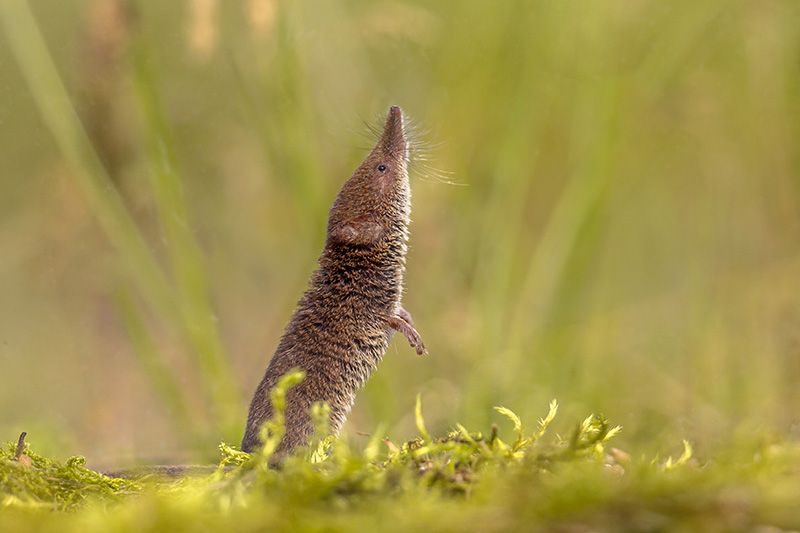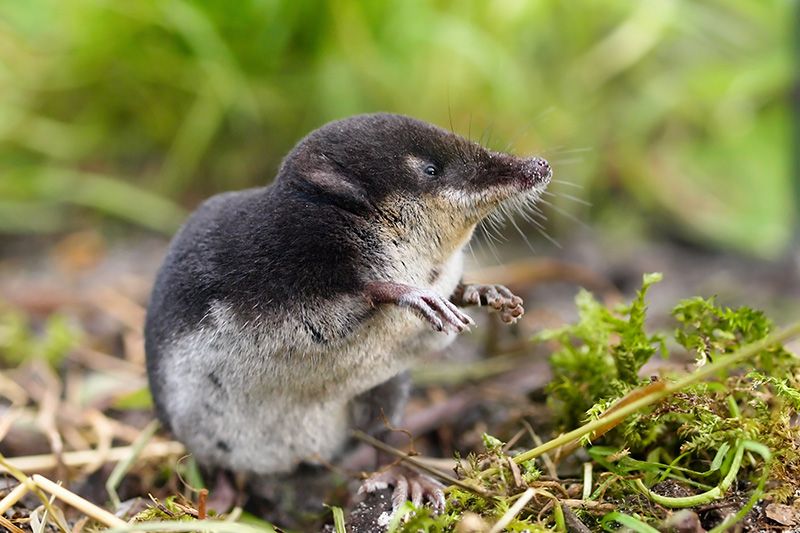Supporter Kenneth Phipps sheds light on some of Britain’s smallest and often overlooked mammals. The British mainland has three species of shrew, common, pygmy, and water shrew, and all of these little insectivores have intriguing lifestyles.
Shrinking shrews
Common, pygmy and water shrews undergo a sudden reduction in body weight during winter. This isn’t due to the loss of fat deposits (dynamic shrews don’t have such stores) but is thought to be due to changes in the skeleton and internal organs. The reasons for this unusual response to the arrival of winter are poorly understood. It could be that it enables shrews to reduce their food requirements during this season. A smaller shrew requires less food than a larger one, and in cold winters, food is often limited.
Selective shrews
The three species of shrew have distinct dietary preferences. Whilst both common and water shrews feed on small invertebrates, the pygmy shrew rarely, if ever, eats earthworms. Various species of nutritious, soil-dwelling worms, however, form a major component of the common shrew’s diet. As a result of these differences, pygmy shrews are able to survive in woodland and mountainous areas where the acidic, often poorly-drained soils support very few worms. In fact, pygmy shrews have been found on Ben Nevis and the Cairngorm plateau. Water shrews favour small, aquatic prey such as freshwater shrimps and the larvae of caddis flies, although they’ll also take small fish and amphibians on occasions.
Short-lived shrews
Shrews are extremely short-lived compared to other small mammals. Adults die after breeding through the summer, before their second winter. Few pygmy or common shrews will live as long as twelve months, but water shrews have been known to survive for nineteen months in the wild.
Secretive shrews
Shrews aren’t the most obvious of British mammals. They tend to spend most of their time in thick undergrowth or in burrows and runways beneath the soil surface, often those produced by mice and voles. Water shrews might be seen by, following the advice of the poet W.H. Davies and taking time ‘to stand and stare’ by freshwater ditches and streams. Shrews killed by domestic cats are often left as they’re distasteful to mammals. Their short life expectancy means that dead shrews are sometimes found on tracks and pathways in well-vegetated areas. The shrill calls and shrieks produced by shrews, too high-pitched for older ears, are often heard by children and gave rise to tales of fairies at the bottom of the garden.
Superlative shrews
All three mainland shrews are red-tipped teeth: a feature unique amongst British small mammals. This is due to iron in the outer layer of the tooth enamel and probably ensures the biting surfaces are resistant to wear. The water shrew is Britain’s only venomous mammal: its saliva contains a neurotoxin that causes paralysis in prey such as newts and frogs. In people, its bite can causeskin irritation and discomfort for several days. All three species are protected under Schedule 6 of the Wildlife and Countryside Act 1981 and cannot be trapped without a licence.
Shrew superstitions
Lifeless shrews found on paths led to the belief that shrews died if they attempted to cross a person’s path. They were also thought to cause lameness in farm animals and generally to bring misfortune. To counteract this magic, a stick from the ‘shrew ash’ was applied to the suffering cow, sheep or horse. This was a twig from an ash tree into which a shrew had been placed into a hole in the trunk and sealed up.
Sara’s shrews
For further information the fascinating natural history of British shrews, consult the excellent publications of Dr Sara Churchfield.
Shrews (Mammal Society series). Anthony Nelson, 1986
Shrews of the British Isles. Shire Publications, 1988
The Natural History of Shrews. Christopher helm, 1990
The Water Shrew Handbook (P. Carter & S. Churchfield). The Mammals Society, 2006
Many of Britain’s mammals are in trouble. If we’re not careful, even common species can be lost before our eyes. That’s why we need your help to monitor mammals and record sightings to protect their future. If you’d like to help us monitor our wild neighbours, take part in our nationwide survey Living with Mammals today.



